DEVELOPMENT OF INDIAN FEDERATION
- Historical Background of Indian Federalism
- Constitutional Provisions of Indian Federalism
- Phases of Indian Federalism
- Impact of GST on Indian Federalism
- Key Issues and Challenges in Indian Federalism
- Key Reforms to Strengthen Indian Federalism
- Role of NITI Aayog in Indian Federalism
- Related FAQs of DEVELOPMENT OF INDIAN FEDERATION
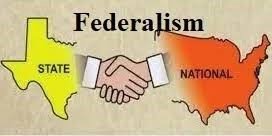 Federalism is defined as a political structure where power is constitutionally divided between the central government and regional governments, with each level having distinct responsibilities and authority. The significance of federalism lies in balancing national unity with regional diversity, ensuring better governance, and preventing the concentration of power.
Federalism is defined as a political structure where power is constitutionally divided between the central government and regional governments, with each level having distinct responsibilities and authority. The significance of federalism lies in balancing national unity with regional diversity, ensuring better governance, and preventing the concentration of power.Significance of Federalism
- Power Sharing: Federalism prevents the concentration of power at one level, allowing both national and regional governments to function independently.
- Political Stability: By accommodating regional identities and aspirations, federalism helps maintain political stability in a diverse nation like India.
- Governance Efficiency: Decentralisation of power enables more responsive and efficient governance at the local level.
- Protection of Minority Interests: Federal structures protect the rights and identities of linguistic, cultural, and religious minorities by granting them political representation and autonomy.
India’s three-tier government structure (Central, State, and Local) ensures that decisions are made at the appropriate level, addressing local and national concerns effectively. The existence of linguistic states and special provisions for certain regions reflects India’s federal character.
Unique Nature of Indian Federalism
Indian federalism is described as “quasi-federal” because it combines the features of both federal and unitary systems, with a strong central authority but significant powers for the states.
- Single Constitution: Unlike the USA, India has a single Constitution governing both the central and state governments.
- Strong Centre: The central government retains significant powers, including the authority to override state legislation under certain circumstances.
- Union List, State List, and Concurrent List: The Constitution divides legislative powers between the Union and State governments. However, in case of conflict, the Union law prevails over the state law.
- Emergency Provisions: During a national emergency, the federal structure becomes unitary, with greater powers vested in the central government.
- Financial Dependence: States rely heavily on financial transfers from the Centre, giving the Union government greater influence over state policies.
- Special Provisions: Certain states (e.g. Nagaland, Mizoram) have been granted special autonomy under the Constitution.
Indian federalism is dynamic, adapting to political, social, and economic changes while balancing central authority with state autonomy. Its unique quasi-federal nature allows India to maintain national unity while accommodating regional diversity.
Historical Background of Indian Federalism
Indian federalism has its roots in the colonial administrative framework established by the British and was later shaped by the deliberations of the Constituent Assembly. The evolution of Indian federalism reflects the attempt to balance central authority with regional autonomy, ensuring national unity while recognising India’s cultural and regional diversity.
- Pre-Independence Federal Structures: The foundation for federalism in India was laid during British rule through various Government of India Acts, especially the Government of India Act, 1935, which introduced the concept of provincial autonomy and division of powers.
- Government of India Act, 1919 (Montagu-Chelmsford Reforms)
- Introduced the system of dyarchy at the provincial level, where subjects were divided into ‘reserved’ and ‘transferred’ categories.
- Reserved subjects (e.g., law and order) were under the control of the Governor (appointed by the Crown), while transferred subjects (e.g., health and education) were managed by Indian ministers.
 While dyarchy introduced a division of powers, the ultimate authority remained with the British Crown.
While dyarchy introduced a division of powers, the ultimate authority remained with the British Crown.
- Government of India Act, 1935
- Established a clear federal structure by dividing powers between the Centre and Provinces under three lists:
- Federal List – Defence, external affairs, railways, etc.
- Provincial List – Education, health, agriculture, etc.
- Concurrent List – Criminal law, marriage and divorce, etc.
- Provided for the creation of an All-India Federation comprising British Indian provinces and princely states (though the princely states refused to join).
- Introduced provincial autonomy, allowing provinces to elect their own legislatures and form governments.
- Reserved powers for the Governor-General to override provincial decisions, maintaining British control over key areas.
- Introduced a bicameral federal legislature at the Centre.
- Established a clear federal structure by dividing powers between the Centre and Provinces under three lists:
The Act of 1935 laid the foundation for the division of legislative powers between the Centre and the states, which was later adopted in the Indian Constitution.
- Influence of British Colonial Administration: The British colonial administration influenced Indian federalism by introducing centralised governance while granting limited autonomy to provinces.
- Centralised Governance: British India was governed through a strong central authority represented by the Governor-General and the Viceroy. The Governor-General had overriding powers in matters of defence, foreign policy, and taxation. Provincial governments had limited financial and legislative authority.
- Princely States and Dualism: Over 500 princely states existed under British suzerainty, each with its own internal governance structure. While British provinces followed the legislative framework of the Government of India Act, princely states were governed by treaties with the Crown. This created a dual system of governance, complicating the federal structure.
- Central Financial Control: The British government controlled financial resources, with provinces dependent on central grants. Provincial governments lacked independent financial authority, reinforcing central dominance.
- Role of the Constituent Assembly: The Constituent Assembly (1946–1950) played a pivotal role in defining the nature and structure of Indian federalism.
- Debates on Centralisation vs Decentralisation: Leaders like Dr. B.R. Ambedkar advocated for a strong Centre to ensure national unity and political stability. Others, like K.M. Munshi and Jawaharlal Nehru, supported a balanced federal structure with adequate powers for states. The threat of partition and communal conflict influenced the decision to create a strong Centre.
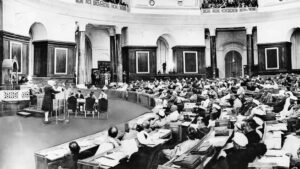 Federal Features Incorporated: Division of powers between the Centre and states through Union List, State List, and Concurrent List (based on the 1935 Act).
Federal Features Incorporated: Division of powers between the Centre and states through Union List, State List, and Concurrent List (based on the 1935 Act).- Equal representation of states in the Rajya Sabha to protect regional interests.
- Provisions for financial devolution through Finance Commission recommendations.
- Independent powers for state legislatures in matters of state concern.
- Unitary Features Retained: Emergency provisions (Articles 352, 356, and 360) allowed the Centre to assume control of state governance during crises. The right of Parliament to legislate on state matters under certain circumstances. Power of the Governor (appointed by the President) to dissolve state legislatures.
- Special Provisions: Special constitutional status for states like Nagaland (Article 371A).
| Dr. B.R. Ambedkar described India as a “Union of States” rather than a federation to reflect the dominance of the Centre over states in certain matters. |
The Indian federal model reflects the historical legacy of British colonial rule while incorporating indigenous principles of governance and constitutional flexibility. This unique blend of federalism and centralisation has enabled India to manage its complex socio-political diversity while maintaining national unity.
Constitutional Provisions of Indian Federalism
Indian federalism is defined and structured through specific constitutional provisions that outline the division of powers, the relationship between the Centre and states, and the mechanisms to resolve conflicts. The Constitution of India establishes a strong Centre while ensuring the autonomy of states, reflecting the unique nature of Indian federalism.
1. Division of Powers under Schedule VII
- Union List (97 subjects) – Parliament has exclusive authority on matters of national importance like defence, foreign affairs, and atomic energy.
- State List (66 subjects) – State legislatures handle local issues like public health, police, and agriculture.
- Concurrent List (47 subjects) – Both Parliament and state legislatures can legislate on subjects like education and criminal law; central law prevails in case of conflict (Article 254). Example: The Right to Education Act (2009) reflects joint action under the Concurrent List.
2. Article 1 – India as a “Union of States”
- The term “Union” reflects the dominance of the Centre and the indestructible nature of the Union. States cannot secede; the Centre retains the power to alter state boundaries under Article 3. Example: The 1956 state reorganisation was carried out under Article 3.
3. Legislative Powers and Central Influence
- Parliament can legislate on State List subjects during a national emergency (Article 250). Parliament can legislate on State List subjects if the Rajya Sabha passes a resolution in the national interest (Article 249).
- Parliament can legislate on State List subjects if two or more states request it (Article 252). Example: The Essential Commodities Act (1955) allows the Centre to regulate essential goods under the Concurrent List.
4. Article 356 – President’s Rule
- The President can impose President’s Rule if a state government fails to function constitutionally. It requires parliamentary approval within two months and can last up to three years with periodic approval.
- The S.R. Bommai Case (1994) established guidelines for judicial review of President’s Rule.
- Indira Gandhi used Article 356 extensively in the 1970s to dismiss opposition-led state governments.
Indian federalism reflects a balance between centralisation and decentralisation. While the Centre retains overriding powers on national issues, states have autonomy in local governance. This flexibility allows Indian federalism to adapt to changing political, social, and economic realities.
Phases of Indian Federalism
Indian federalism has evolved through distinct phases, shaped by political, economic, and social changes. While the Constitution established a strong Centre, the relationship between the Centre and the states has undergone significant changes due to political realignments, constitutional amendments, and judicial interpretations.
- Post-Independence Integration (1947–1950): After independence, the immediate challenge was to integrate the over 565 princely states and former British provinces into the Indian Union. This phase laid the foundation for a unified Indian federal structure under the leadership of Sardar Vallabhbhai Patel.
- Role of Sardar Patel: Patel employed diplomatic and military strategies to convince princely states to join the Indian Union. The Instruments of Accession allowed princely states to surrender control over defence, foreign affairs, and communications to the Centre while retaining autonomy in other areas.
- Hyderabad and Junagarh Integration: Military action (Operation Polo) was used to annex Hyderabad in 1948. Junagarh was integrated through a referendum. Kashmir acceded to India under special circumstances following Pakistani aggression.
- Constitutional Foundation: The Constitution of India (1950) established India as a “Union of States.” The Centre retained significant powers over the states to maintain unity and integrity.
- State Reorganization (1956): The reorganization of states along linguistic lines was a defining moment in Indian federalism, reinforcing regional identities while preserving national unity.
- Demand for Linguistic States: The demand for linguistic states emerged due to cultural and linguistic diversity. The formation of Andhra Pradesh (1953), following the death of Potti Sriramulu after a hunger strike, intensified calls for linguistic states.
- State Reorganization Act (1956): The State Reorganization Commission (1953), chaired by Fazl Ali, recommended the formation of states on linguistic lines. The number of Indian states was reduced from 27 to 14 states and 6 Union Territories.
- Impact on Federalism: Strengthened regional identities while reinforcing the federal structure and it allowed regional political representation and enhanced state autonomy.
The creation of Maharashtra and Gujarat in 1960 further strengthened the linguistic basis of Indian federalism. The demand for separate states based on ethnicity and regional identity (e.g., Nagaland in 1963) reflected the growing assertion of federal principles.
- Emergency Period (1975–77): The Emergency imposed by Indira Gandhi marked a significant shift toward centralization, undermining the federal balance.
- Declaration of Emergency: Emergency was declared on June 25, 1975, under Article 352 (internal disturbance). Fundamental rights were suspended, and political opposition was suppressed.
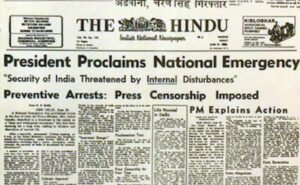 Impact on Federalism: State governments were dismissed, and Centre-appointed governors assumed greater control over state administration. The Centre used Article 356 (President’s Rule) to weaken opposition-led state governments. The judiciary was curtailed through constitutional amendments (42nd Amendment).
Impact on Federalism: State governments were dismissed, and Centre-appointed governors assumed greater control over state administration. The Centre used Article 356 (President’s Rule) to weaken opposition-led state governments. The judiciary was curtailed through constitutional amendments (42nd Amendment).- Judicial Response: The Supreme Court, in the Kesavananda Bharati Case (1973), established the doctrine of Basic Structure, limiting Parliament’s power to alter the federal structure. The S.R. Bommai Case (1994) later established that the imposition of President’s Rule must pass judicial scrutiny.
The dismissal of state governments and political arrests reflected the weakening of state autonomy during the Emergency. The Supreme Court’s ruling in the Minerva Mills Case (1980) reinforced the principle of limited central power.
- Coalition Era (1989–2004): The decline of single-party dominance and the emergence of coalition governments led to a resurgence of state power and cooperative federalism.
- Rise of Regional Parties: Regional parties like the DMK, AIADMK, Shiv Sena, and TDP gained influence. National coalitions depended on the support of regional parties, enhancing their bargaining power.
- Impact on Federalism: State governments gained greater fiscal and political autonomy. Regional demands influenced national policy (e.g., special economic packages for states). Federalism became more balanced as state governments exercised greater control over local issues.
- Judicial Interventions: The S.R. Bommai Case (1994) limited the arbitrary dismissal of state governments under Article 356. The judiciary upheld state autonomy and reinforced cooperative federalism.
The rise of the United Front Government (1996–98) and the NDA (1998–2004) reflected the increasing influence of regional parties in national governance. The introduction of the Panchayati Raj Act (1992) further strengthened grassroots federalism.
- Post-Liberalization Phase (1991–Present) : The economic reforms of 1991 and the introduction of cooperative federalism reshaped Centre-State relations and enhanced state-level autonomy.
- Economic Reforms: The 1991 economic reforms introduced Liberalization, Privatization, and Globalization (LPG). States gained greater freedom to attract foreign investment and manage industrial policies. The emergence of regional growth hubs increased state-level economic competition.
- Introduction of GST (2017): The Goods and Services Tax (GST) created a unified national market. The GST Council established a model of fiscal federalism, with the Centre and states jointly deciding tax rates and revenue sharing.
- Role of NITI Aayog: The Planning Commission was replaced by the NITI Aayog in 2015 to enhance participatory governance. NITI Aayog adopted a “bottom-up” approach, encouraging state participation in policy-making.
- Judicial Safeguards: The Supreme Court upheld the federal principles in cases like the Sabarimala Temple Case (2018) and the Karnataka Political Crisis (2019). The judiciary reinforced the need for state autonomy in legislative and executive matters.
Impact of GST on Indian Federalism
The Goods and Services Tax (GST), implemented in 2017, marked a significant shift in India’s fiscal federalism by creating a unified tax structure. It aimed to replace the complex system of multiple state and central taxes, fostering a common national market while altering the financial relationship between the Centre and States. GST was introduced to simplify taxation, increase revenue collection, and improve tax compliance, but it also raised concerns about the autonomy of states in financial matters.
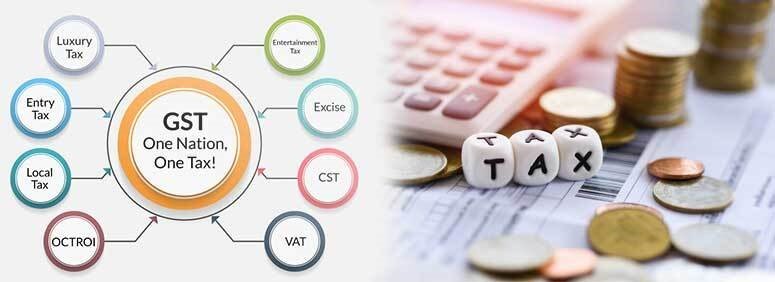 Positive Impact of GST: GST streamlined the tax system, reducing tax evasion and creating a single national market. It increased tax compliance and widened the tax base, boosting overall revenue collection.
Positive Impact of GST: GST streamlined the tax system, reducing tax evasion and creating a single national market. It increased tax compliance and widened the tax base, boosting overall revenue collection.- Challenge to Fiscal Federalism: GST limited states’ power to levy independent taxes on goods and services, reducing their fiscal autonomy. States now depend on the Centre for GST compensation, affecting their financial independence.
- Cooperative Federalism through GST Council: The GST Council includes representatives from both the Centre and States, promoting consensus-based decision-making. This reflects a shift from competitive to cooperative federalism.
- Uniformity in Taxation: GST introduced uniform tax rates across the country, reducing tax-related trade barriers and improving ease of doing business. It fostered economic integration and reduced logistical costs.
- Revenue Loss and Compensation Issue: Some states faced a decline in revenue after GST implementation, leading to disputes over delayed GST compensation payments by the Centre. This strained Centre-State financial relations.
- Strengthening of Inter-Governmental Relations: GST increased interaction between the Centre and States through the GST Council, improving dialogue and coordination on economic matters.
GST has strengthened economic federalism by creating a unified market and increasing revenue collection. However, it has also reduced states’ fiscal independence, highlighting the need for a balanced approach to fiscal federalism where both the Centre and States retain sufficient financial powers.
Indian federalism has evolved from a highly centralised model to a more balanced structure that reflects regional diversity and state-level autonomy. The shift from political federalism to economic federalism has strengthened the role of states in India’s growth story while maintaining national unity.
Key Issues and Challenges in Indian Federalism
Indian federalism is characterized by a complex balance of power between the Centre and the states. Despite constitutional safeguards, tensions often arise over political control, financial distribution, and regional autonomy. These challenges impact governance and the cooperative nature of federalism.
- Centre-State Relations: Tensions arise due to the Centre’s legislative and administrative control over state matters. The Centre can legislate on State List subjects under Article 249 and impose President’s Rule (Article 356), affecting state autonomy. Example: President’s Rule in Arunachal Pradesh (2016) triggered legal controversy.
- Law Enforcement Issues: Police and public order are state subjects, but the Centre can deploy paramilitary forces without state consent. Central agencies like CBI and NIA’s jurisdiction over state matters creates friction. Example: Extending BSF’s jurisdiction from 15 km to 50 km inside state borders (2021) was opposed by states.
- Fiscal Federalism: Under Article 280, the Finance Commission recommends tax distribution between Centre and states, but the Centre controls major tax revenues. GST has limited states’ power to impose indirect taxes. Example: Delay in GST compensation during COVID-19 strained fiscal relations.
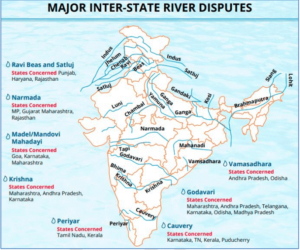 Regionalism and Demand for Statehood: Movements for greater autonomy challenge Indian federalism. Telangana (2014) was created after prolonged agitation. Gorkhaland and Bodoland movements highlight regional tensions. Example: Telangana’s formation addressed regional grievances, but Gorkhaland remains unresolved.
Regionalism and Demand for Statehood: Movements for greater autonomy challenge Indian federalism. Telangana (2014) was created after prolonged agitation. Gorkhaland and Bodoland movements highlight regional tensions. Example: Telangana’s formation addressed regional grievances, but Gorkhaland remains unresolved.- Inter-State Disputes: River water and border disputes create friction among states. Example: Cauvery Water Dispute between Tamil Nadu and Karnataka (resolved in 2018) and Assam-Mizoram border clashes reflect inter-state tensions.
- Role of Governor: Governors are appointed by the President and have discretionary powers under Article 356. Allegations of misuse arise when opposition-led governments are dismissed. Example: Maharashtra political crisis (2019) reflected political interference through the Governor’s role.
- Judicial Interventions: The S.R. Bommai Case (1994) established guidelines for imposing President’s Rule, limiting political misuse. Example: The Supreme Court’s judgment reinforced that Article 356 cannot be used for political gains.
- Challenges to Cooperative Federalism: Issues over financial distribution, political dominance, and administrative overreach challenge Centre-state harmony. Example: Tensions over delayed GST compensation and increased BSF jurisdiction highlight ongoing Centre-state conflicts.
Key Reforms to Strengthen Indian Federalism
Indian federalism requires structural and institutional reforms to address political, financial, and administrative challenges. Strengthening Centre-state relations and empowering states is essential for cooperative and competitive federalism.
- Greater Financial and Administrative Autonomy for States – Increasing states’ share in tax devolution (currently 41%) and reducing centrally sponsored schemes will enhance financial independence and local governance. (Example: 14th Finance Commission increased states’ share from 32% to 42%)
- Strengthening Inter-State Council and NITI Aayog – Granting more authority to the Inter-State Council (Article 263) and giving constitutional status to NITI Aayog will improve Centre-state dialogue and policy alignment. (Example: Inter-State Council reactivated in 2016 after 10 years)
- Balancing Central Authority with State Rights and Regional Aspirations – Limiting misuse of Article 356, strengthening state roles in law enforcement, and addressing regional autonomy demands will promote stability. (Example: S.R. Bommai Case (1994) restricted arbitrary imposition of President’s Rule)
- Promoting Competitive and Cooperative Federalism – Encouraging state-level innovation and timely GST compensation will enhance fiscal stability and governance efficiency. (Example: Aspirational Districts Programme (2018) fostered state-level competition)
- Resolving Inter-State Disputes – Empowering independent tribunals and judicial oversight will ensure quicker resolution of river water and border disputes. (Example: Supreme Court’s verdict in the Cauvery Water Dispute (2018) ensured equitable water-sharing)
- Reforming the Role of the Governor – Appointing Governors in consultation with states and limiting discretionary powers under Article 356 will reduce political interference. (Example: Maharashtra political crisis (2019) highlighted the need for a neutral Governor’s role)
Role of NITI Aayog in Indian Federalism
NITI Aayog (National Institution for Transforming India) was established in 2015, replacing the Planning Commission, to promote cooperative and competitive federalism in India. It aims to strengthen the federal structure by enhancing collaboration between the Centre and states while allowing greater flexibility in policy implementation.
 Cooperative Federalism: NITI Aayog promotes cooperative federalism by involving states in policy-making through platforms like the Governing Council, ensuring that state governments have a say in national development strategies.
Cooperative Federalism: NITI Aayog promotes cooperative federalism by involving states in policy-making through platforms like the Governing Council, ensuring that state governments have a say in national development strategies.- Competitive Federalism: It encourages healthy competition among states by ranking them on performance indices such as Ease of Doing Business and Health and Education outcomes, driving policy improvements.
- Decentralized Planning: Unlike the centralized approach of the Planning Commission, NITI Aayog allows states to design their own developmental strategies according to local needs and priorities.
- Flexibility in Resource Allocation: NITI Aayog does not allocate funds directly but provides policy advice, enabling states to have greater financial autonomy in planning and implementing developmental programs.
- Policy Innovation and Experimentation: NITI Aayog acts as a policy think tank, helping states adopt innovative models and best practices, especially in health, education, and infrastructure.
- Direct Engagement with States: Through initiatives like the Aspirational Districts Programme, NITI Aayog works directly with state governments to improve governance and development in underdeveloped regions.
- Regional and Sectoral Planning: It facilitates regional cooperation among states to address cross-border issues and sector-specific challenges, such as water sharing and infrastructure development.
- Performance Monitoring and Accountability: NITI Aayog tracks the progress of various government schemes, providing real-time data and feedback to states, encouraging evidence-based policymaking.
Criticism
- Lack of Financial Power: Unlike the Planning Commission, NITI Aayog does not have the authority to allocate funds to states, reducing its influence over state-level development.
- Over-Centralization: Despite the focus on cooperative federalism, the central government retains significant control over key policy decisions, limiting the autonomy of states.
- Limited Impact on Fiscal Federalism: The Finance Commission, not NITI Aayog, determines financial devolution, weakening NITI Aayog’s role in balancing fiscal relations between the Centre and states.
- Policy-Driven, Not Implementation-Driven: NITI Aayog primarily serves as an advisory body without direct implementation power, reducing its effectiveness in addressing grassroots issues.
NITI Aayog has played a pivotal role in strengthening Indian federalism by promoting greater cooperation and competition among states. However, its lack of financial authority and over-reliance on the central government limit its ability to address regional disparities and empower states fully.
Conclusion
Indian federalism, despite its inherent challenges, has been instrumental in maintaining India’s unity and accommodating its vast diversity. Strengthening state autonomy, addressing fiscal imbalances, resolving inter-state disputes, and ensuring cooperative governance will be crucial for sustaining a harmonious federal structure. A balanced approach between central authority and state rights will define the future of Indian federalism in the 21st century.
Related FAQs of DEVELOPMENT OF INDIAN FEDERATION
Indian federalism is often described as “quasi-federal”. While it divides power between the Centre and states, the Centre holds more authority, especially in times of emergency or conflict. Unlike the U.S., India has one Constitution, a strong Centre, and the power to alter state boundaries (Article 3).
Federalism helps balance unity and diversity. It allows local governance, respects regional identities, and prevents the concentration of power. It also gives space for minority voices, improving stability and governance in a multilingual and multicultural society like India.
Absolutely. Indian federalism has evolved across five phases — from post-independence integration, linguistic reorganisation, and emergency centralisation, to coalition politics and post-liberalisation fiscal reforms like GST and NITI Aayog. Today, it’s a mix of cooperative and competitive federalism.
Key challenges include Centre-state tensions, fiscal imbalance (due to GST), inter-state disputes (like water sharing), and political misuse of Article 356 (President’s Rule). There’s also regionalism, language issues, and growing demands for new states.
Reforms like increasing financial autonomy of states, strengthening the Inter-State Council, limiting the Governor’s discretionary powers, timely GST compensation, and encouraging state innovation through programs like Aspirational Districts can boost both cooperative and competitive federalism.



